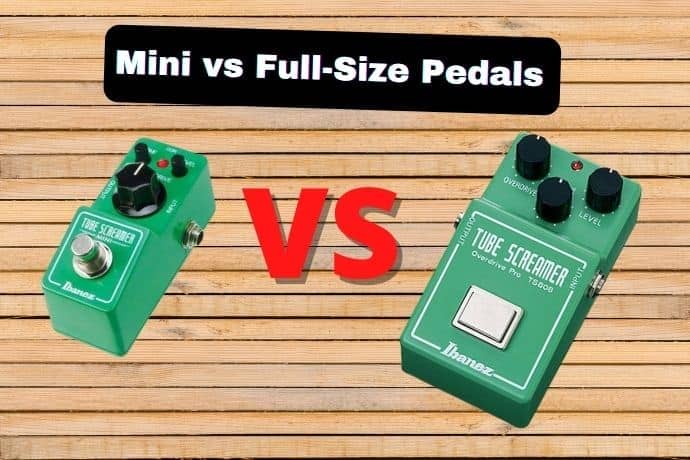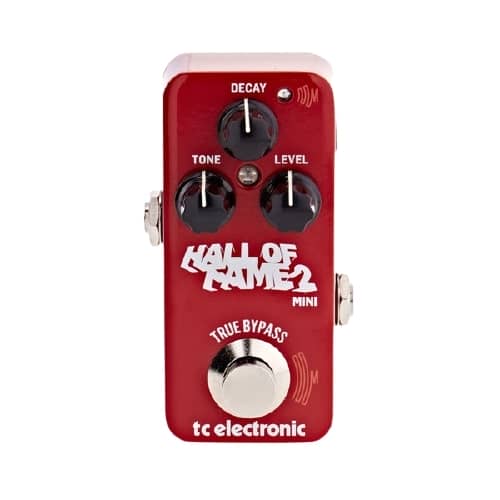Pedals are tools for unlocking new tones and textures for guitar players, hence why we love them!
With that said, mini pedals are increasingly popular due to their size and price. However, are mini pedals better than regular-sized pedals, or is bigger better?

This informative post will discuss the min pedal vs. regular pedal debate discussing sound, price, and features. Sound good?
What is the difference between mini and regular sized guitar pedals?
Mini pedals save space on a pedalboard, allowing room for additional pedals and sounds. They also sound just as good as regular-sized pedals and can be cheaper to buy. In contrast, regular size pedals have a larger interface with more tone-shaping parameters and large enough for battery power.
Mini Guitar Pedals – Overview

To put it simply, mini guitar pedals are just more compact versions of regular pedals used to see in guitar players’ rigs.
As you may already assume from their name, the main important trait is the noticeably smaller size.
Because of this kind of design, they’re pretty popular among some guitar players.
No matter the musical style or the kind of other gear that one has, there’s a high chance that an average pedalboard enthusiast has at least one of these in their arsenal.
As we know them today, the regular compact pedals came into action sometime during the late 1970s.
Although other companies had exciting stuff over the years, it’s Boss, Maxon, and Ibanez that finally introduced these kinds of pedals in now standardized modestly-sized metal casings.
But the mini-sized pedals came into action sometime during the 2000s and 2010s, getting a lot of praise from guitar players from all sides of the world.
Some Classic Mini Pedals Are…
- Ibanez Tube Screamer Mini – a bite-sized version of the legendary tube screamer pedal
- Dunlop Mini Wah – a pocked size version of the original cry baby wah
- Tone City Plexi – a popular mini pedal modeling the iconic distortion of a Marshall Plexi amplifier
- TC- Electronic Hall of Fame Mini 2 – classic reverb pedal – just smaller
- TC-Electronic Ditto Looper Mini – classic looper pedal, only less complicated
- Dunlop FFM3 Jimi Hendrix Fuzz Face Mini – Jimi’s classic fuzz face – fuzzy goodness in a smaller package
Pros of Mini Pedals
One of the first things that might come to your mind here is “what’s the advantage of these mini-sized pedals?”
Well, the most obvious one is the smaller size, making them a great addition to an already crowded pedalboard.
You no longer need to worry about finding more room on your preferred surface.
Simultaneously, their convenience comes as a great advantage, making them fairly useful and straightforward, no matter the type of effect we’re talking about.
For example, a full-sized wah pedal takes a ton of pedalboard real estate. Therefore, a mini version is a perfect addition to if you don’t use it regularly, allowing you more space for more effects.
But aside from having more room and overall practicality on your pedalboard, some other advantages come with mini-sized pedals.
If you use these smaller devices predominantly, you’ll have options to use more effects, making your pedalboardmore versatile.
In the end, it’s also important to note that mini-sized pedals can come as a great option as a backup in case some of your other devices malfunction.
Mini pedals can be a great addition to your pedalboard as your ‘set it and forget it pedals’ such as reverb, compression, etc.
The reason is if you don’t need advanced tone shaping options from these effects.
Then mini pedals are the perfect solution to have effects available to your rig so you don’t miss out on these sounds while saving space on a cramped pedalboard.
Cons of Mini Pedals
Of course, just like with any kind of device or an effect, everything comes advantages and disadvantages.
As far as the downsides go, mini-sized pedals come with some flaws that are, to be fair, even unacceptable to some guitar players.
Firstly, plenty of these mini-sized pedals are simplified and even downgraded versions of the original full-sized models.
This means that they have fewer controls, and their tone might suffer as the result of having less room to make a proper circuit for it.
Another issue that guitar players might have is that they’re not that easy to step on.
Despite their build quality, they can be a bit “flimsy” when you step on them on your pedalboard, especially during live shows where you can’t be completely focused on what you’re doing down there.
What’s more, many of these pedals can only be powered by using an external power source.
You can’t just put a battery in there, which is probably frustrating for some musicians who prefer to have it this way.
Do Mini Pedals Sound Just as Good as Full-Sized Pedals?
In a lot of cases, these mini-sized pedals can achieve the same exact tones of their larger versions. For instance, the mini-sized Tube Screamer has an identical tone to the regular-sized one.
Of course, there are examples where the tone differs between these two versions. None of these would be “better” or “worse,” but rather just different.
But even if there are some differences between the regular and miniature sizes of the same model, both will sound pretty close.
In some cases, however, these two different versions will have a noticeably different tone.
The smaller size provides less room for more complex circuits. Additionally, if a pedal has fewer control knobs, this not only gives fewer parameters to control but will also impact its tone due to the different distribution of its components.
A Pedalboard With Just Mini Pedals?
It’s really great about the electric guitar that you’re free to do as you wish. There are no strict rules and laws on what you should or should not do.
Sure, there are advisable things in case you want to have the most precise possible tone and most practical functionalities.
But you’ll still be able to do whatever you want and arrange things the way it works best for you.
With this being said, some guitar players might wonder whether they can have a pedalboard that features only mini-sized pedals. This is technically doable, and nothing really stops you from doing so.
In fact, there are guitar players out there that have this kind of setup.
And it comes with some advantages, mostly if you prefer to have more effects on a smaller surface.
At the end of the day, it’s mostly a personal preference, but you’ll need to have all the advantages and disadvantages of mini-sized pedals in mind before jumping in on this whole adventure.
Price of Mini Guitar Pedals – Cheaper?
In almost all cases, smaller pedals cost less compared to bigger pedals.
If we took the same model of a mini-sized and a regular-sized pedal, the smaller version is usually 20 to 30 percent cheaper than the original.
Of course, this comes along with fewer features, fewer controls, sometimes even a different tone.
However, as we already explained, neither of these will be better or worse. It just comes down to personal preferences and some advantages and disadvantages that we mentioned.
Full-sized pedals will cost more not only due to having more features but also due to more material used to produce them, as well as their reputation and market value.
Comparing the regular TS9 Ibanez Tube Screamer and its mini version, the difference in price is about 20%.
However, looking into a pedal like MXR’s Carbon Copy analog delay, the price is exactly the same.
We have the same analog circuitry and exactly the same controls and features, so it’s obvious that they’re going to cost the same.
Regular-Sized Pedals – Overview

We could spend days talking about the history and evolution of guitar pedals and other effect units.
But one thing remains the same – conventional regular-sized pedals are still the most popular choice among guitar players of pretty much all musical styles.
Sure, one part of that has to do with the fact that they’re most widespread on the market.
Other things have to do with the fact that most of the other gear is standardized to work with regular-sized pedals.
So despite the fact that mini-sized pedals can be more practical, it turns out that it’s usually more practical to use regular-sized pedals. It’s kind of confusing, right?
But all the jokes aside, using normal conventional pedal is way more common compared to using their small-sized counterparts. Additionally, they come with a few more features than smaller pedals, at least in most cases.
Pros of Regular-Sized Pedals
Now that we cleared things up, what they are the advantages of these regular-sized pedals are.
As you may have already assumed, according to what we’ve written, one of the biggest advantages is that they’re widely available and that most of the pedalboards are standardized according to conventional pedals.
But there are a few other things to consider here. First, regular-sized pedals more often have an option to work with a 9V battery, since their larger size allows them to have a separate compartment.
Additionally, the bigger size comes with its own advantages, mostly because you can fit in more components in there and a larger circuit.
This means that they usually come with a few more tone-shaping controls that make guitar players’ lives easier. What’s more, this bigger size also makes them much easier to step on.
Cons of Regular–Sized Pedals
But as you may assume by now, there are some downsides to regular pedals compared to their smaller versions.
Looking at these conventional devices, they take up a significantly larger portion of space on your pedalboard or any improvised surface where you’re keeping them.
These days, many guitar players are complaining about having less space in there, especially those who prefer to have an abundance of effects for shaping their tone. And it’s a pretty big struggle for some.
Looking more into some of the downsides, larger versions of pedals, no matter the type of effect that we’re talking about, cost more.
If you would, hypothetically, create the same signal chain from the full-sized models and another one from the same exact versions that are mini-sized, you’d have a significant difference in the total cost between these two signal chains.
Price of Regular-Sized Guitar Pedals
As you already know by now, regular-sized pedals will usually cost more compared to their mini versions, up to 30%.
The exact price depends on the type of effect, brand, the same model and its quality, and its market value.
Now, let’s take an average distortion or an overdrive pedal. Regular-sized versions usually go anywhere between $50 and $150.
Of course, we have more expensive examples, but you’ll find a great one for a pretty reasonable price.
What’s more, some famous guitar heroes use relatively cheap pedals, including Boss’Boss’s well-known DS-1.
Mini Pedals vs. Regular – Verdict
As I have discussed, both types of pedals are excellent tools for your live rig. In reality, most players will include a mix of min and full-sized effect pedals on their pedalboard uniting as one.
Depending on your tastes and preferences, how you utilize your pedals is key to fulfilling your tone requirements.
Final Thoughts
In the end, there’s no right or wrong choice here, just what suits your needs. The best idea is to try and see what works best for you and your settings. Sure, you’ll save up money and space with smaller pedals. However, regular-sized ones do come with more possibilities and tone-shaping parameters.
Read My Next Post
before you go, learn through my detailed post how to connect your guitar pedals to an audio interface. The reason is so you can record your favorite guitar tones for professional guitar tracks. You can view this post here!
